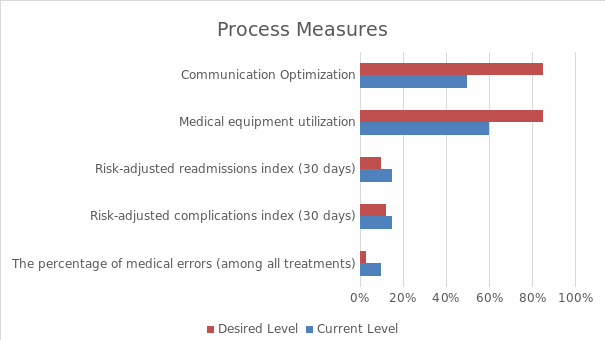Summary
Data collection is an effective method to understand the root cause of the problem and identify an appropriate solution. In the previous paper, data integrity in healthcare was a proposed Best Practice response to the tragedy that occurred due to organizational failure. However, conducting a preliminary analysis of the problem and developing a comprehensive spreadsheet of relevant metrics is essential. In the current paper, structural, process, and outcome measures act as quality indicators of the organizational environment in the facility. Ultimately, data analysis plays a vital part in the improvement of the healthcare practice.
Quality Measures Overview
Structural, process, and outcome measures are essential metrics for any improvement in the healthcare industry. This framework was developed by Avedis Donabedian to create a complex approach to resolving problems in the workplace (Lorini et al., 2018). The structural domain concerns organizational issues, process measures refer to activities by the practitioners, and the outcome domain evaluates the changes (Lorini et al., 2018). According to the research by Watson Health (2021), vast emphasis on quality metrics and consequent response separates the best hospitals from the medium-performing facilities. Namely, the authors have found that more than 70,000 additional lives could be saved in hospitals in the US if all hospitals achieved the same quality standards (Watson Health, 2021). Based on the overview of the quality metrics, the current paper proposes a spreadsheet and a chart on data collection, presented in Table 1 and Figure 1, respectively.
Table 1: Response to Organizational Failure in the Workplace

Graph Analysis and Mock Data Interpretation
The primary data collection methods are direct observation, medical records, internal facility data, and surveys, depending on the type of quality metrics. For instance, conducting surveys is an optimal choice to identify any potential health complications of patients in the 30-days period after release from the hospital. The proposed measures in Table 1 directly relate to the issue of organizational failure, which was suggested as the primary root cause of the tragedy. Consequently, all metrics are necessary to identify the most relevant problematic points of the facility, such as the lack of high-quality communication and organizational structure. Lastly, the mock data presented in Table 1 and Figure 1 could be interpreted as the potential outcome of the suggested response. For instance, better communication and data accessibility would drastically reduce the number of medical mistakes and improve the quality of healthcare services. Ultimately, the current paper has demonstrated the potential impact of the proposed Best Practice solution by applying the data analysis approach.
References
Lorini, C., Porchia, B. R., Pieralli, F., & Bonaccorsi, G. (2018). Process, structural, and outcome quality indicators of nutritional care in nursing homes: A systematic review. BMC Health Services Research, 18(1), 1-14.
Watson Health. (2021). 100 top hospitals(28th edition).